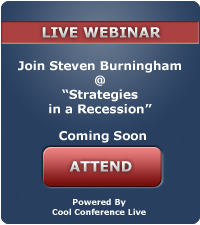Selling in a Tough Economy
 Saturday, May 29, 2010 at 01:13PM
Saturday, May 29, 2010 at 01:13PM Customers’ buying behaviors have changed dramatically and will probably not return to the “good old days” of pre-2008. In the last 24 months, the loss of global wealth is over 50 trillion dollars. Retailing has changed forever with the attempt to manage risks by lowering spending, reducing deal size, cutting costs, downsizing staff, and blaming consumers for not shopping as much. At the same time, consumers are suffering from foreclosures, lost jobs, stock market drops, higher prices, and higher taxes. It is a vicious cycle. The downturn in our economy, for the first time in recent recessions, has affected the luxury market. All of these factors are leading to a longer sales cycle and delayed purchase decisions.
So how do retailers sell in a slow economy that’s literally killing off many independent retailers and restaurants? I believe, as I mentioned earlier in my blog, that the key to success is a “back to business basics” approach mixed with good old-fashioned creativity. In our world, changes happen fast and you have to react quickly.
Here are some tips on how retailers can increase sales tickets.
1. Increase sales and decrease costs.
The first thing a retailer should focus on is a capital increase. Improving the customer’s experience with less money is going to be a challenge. Let’s take a look at companies that continue to do well, such as Apple, Buckle, and Urban Outfitters. What are those retailers doing well? Is it unusual merchandising, special events, or a better-trained staff with longevity? Learn from other retailers’ mistakes, such as Circuit City. They got rid of 3,400 of their best sales people and brought in untrained sale people to cut costs, which was a disaster. This move, along with others, forced them into liquidation. Saks held a 70 percent off Thanksgiving sale that caused havoc with the luxury market around the country and resulted in several long-standing specialty store chains to go out of business. The media described it as the running of the bulls.
2. Learn how to communicate with your customers.
We are in the technology age. Communicate with you customers through their email, social media, twitter, face book, Google, and Yahoo. Use methodologies and strategic skills to equip yourself with the knowledge necessary to plan and implement a successful SEO campaign for maximum possible returns. What is the most effective way to communicate with them to get them into your store? Some retailers have become very creative. They are serving soft drinks, wine, and are hosting special events to get customers into their stores.
3. Improve your customers’ experiences.
Make sure that your staff is well trained so that they can increase the units per transaction and average sales dollar. It’s important that your retail store looks good. If you want to your fool customers into thinking you have new merchandise, do re-merchandising and floor moves. Remember the first 18 feet of the store and your windows are absolutely critical to your store look. Well-lit and frequently changed store windows add appeal. The location of outside signage is also very important.
4. Second-sell impulse items at the point of sale or in your showroom.
Make sure that your staff knows at least five things that can be sold or go with every item. Your employees need to be trained on how to second-sell services and products. If you are working in a fast-food restaurant and a customer tells you that they want a hamburger and a drink, your employee needs to say, “Do you want cheese on that hamburger and would you like a medium or large drink with an apple turnover?” A furniture store should display pictures, paper weights, trays, pens, and scissor holders on top of the desks in their showrooms. You can definitely increase the average sale with impulse items at the counter. Bed Bath and Beyond and the Container Store do a magnificent job. The customer has already opened his or her wallet–which is the first hurdle–and is already buying something. It is difficult for any customer to get out of their stores without buying additional impulse items due to their pricing and the way merchandise is displayed. Remember the revenue from those impulse items goes right to the bottom line. However, a bad cost example is when Starbucks put appliances in their stores. The appliances, movies, and all kinds of extraneous items were cluttering up their stores. The merchandise was not turning fast enough. Retailers really need to focus on what they can cut that will not undermine their sales. Stores like Best Buy are reducing their closing time by one hour in their eastern operations. They listened to their customers who told them that they would rather have more staff available when more people are in their stores. During the late hours from 9:00pm to 10:00pm, there is more staff than customers. You need to focus on and determine where you can cut costs.
5. Work with your landlords.
One of the first discussions you should have is with your landlord. Landlords know what is going on and they need to share in the pain. In fact, in many places retailers have gone to the landlord and negotiated a percentage rent. Others have asked for a reduction of monthly rent. You should also take a look at reducing your footprint. It is very expensive to have a store that is too large. Another option is to sublease some of your space to a complementary service. This will reduce your costs and attract more customers into your store.
6. Be creative; look into barter.
Barter is a great way to acquire additional merchandise. This is trading goods and services without the exchange of money. There is a resurgence to barter and there are many sites that you should take a look at such as www.natecorporationbarter.com, www.u-exchange.com, www.irta.com, and www.bizx.com. Barter is good for items like shopping bags and tissue. You should also take goods on consignment whenever possible. This will help you conserve cash, again reducing your costs. You just pay for what you sell and send back inventory that does not sell.
7. Negotiate with vendors.
Another very important thing to do is vendor negotiations. This enables you to get better terms, better pricing, and the ability to return problematic merchandise. Reduce your open purchase orders by making sure that you are ordering the minimum amount.
8. Understand what your customer wants.
One important thing is to look at what things the customers are NOT buying from you. Retailers are immersed in data that tells them what is selling and what isn’t selling. They order more of what is selling and less of what is not selling. But they do not know what customers are buying from other retailers. You need to understand your customers and what they are buying from the competition. It is important to get a handle on that because it creates new opportunities. Find the needs offer gap–weigh customer needs against what you offer. If a retailer can close that gap, it will open more opportunities. When a clerk or sales associate asks a customer if they found everything that they were looking for and follows that question with, “Was there anything that you wanted that we did not have in stock?” This could give you information about new items that you should stock.
In summary, one of the biggest opportunities is to sell the customer what he needs. Close the needs offer gap. Thinking creatively is really tough in an environment where everyone is shell-shocked and in a bunker. You should be saying to yourself, “These are my most profitable customers. What else are they buying, from whom are they buying, and would it make sense in my store?” If we could stop the bleeding or get an increase in sales, that would be a huge step for most retailers. Store sales for most retailers have plummeted, with a few exceptions–like Wal-Mart. Costs can be evaluated by going through the income statement line by line. The greatest costs will be the landlords, vendors, and payroll. If you can make some headway on those big costs, you will create your greatest opportunity. However, when it comes to payroll, do not be short-sighted about your staff. They are the ones who are making things happen and are in contact and communicating with your loyal customers. They are knowledgeable about your products and services. Ongoing training should be at the top of your to-do list.
 Retail services,
Retail services,  Sales,
Sales,  buy sell,
buy sell,  financial services in
financial services in  Sales Tips
Sales Tips 






Reader Comments